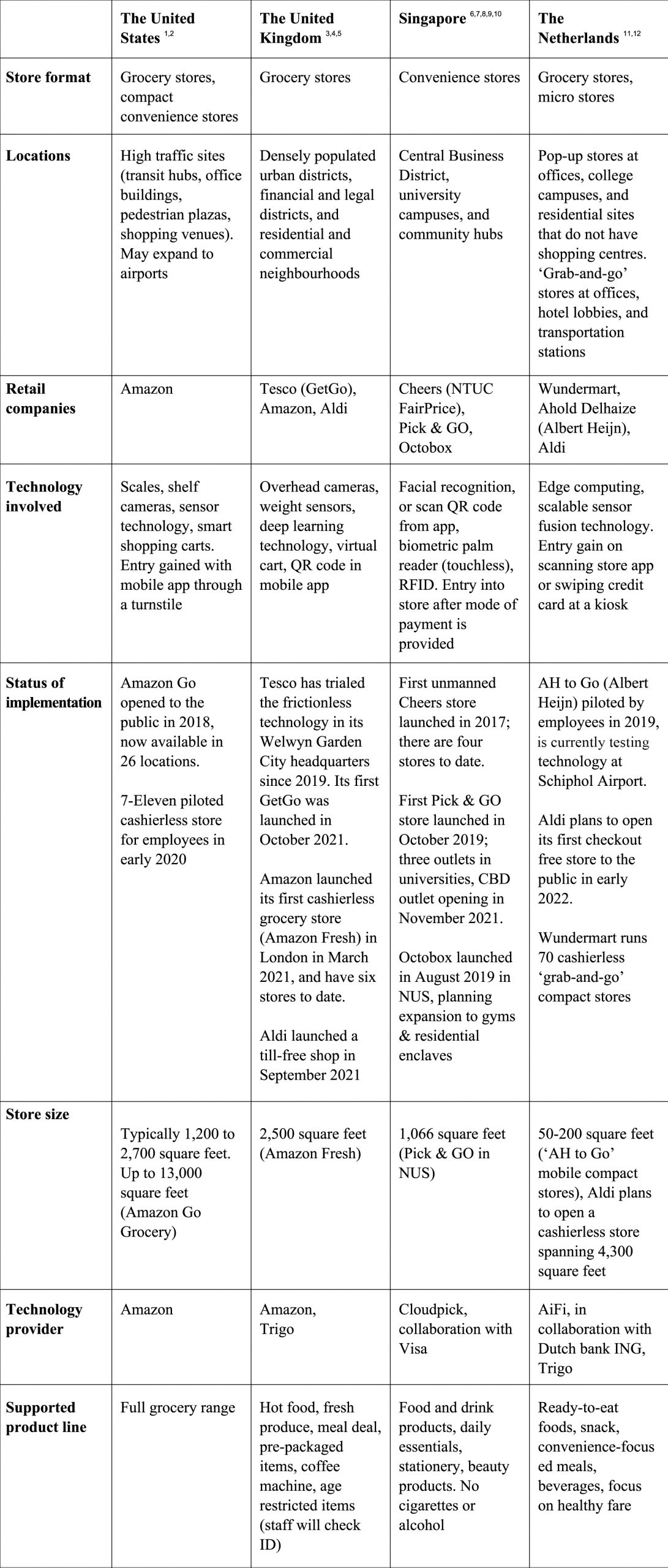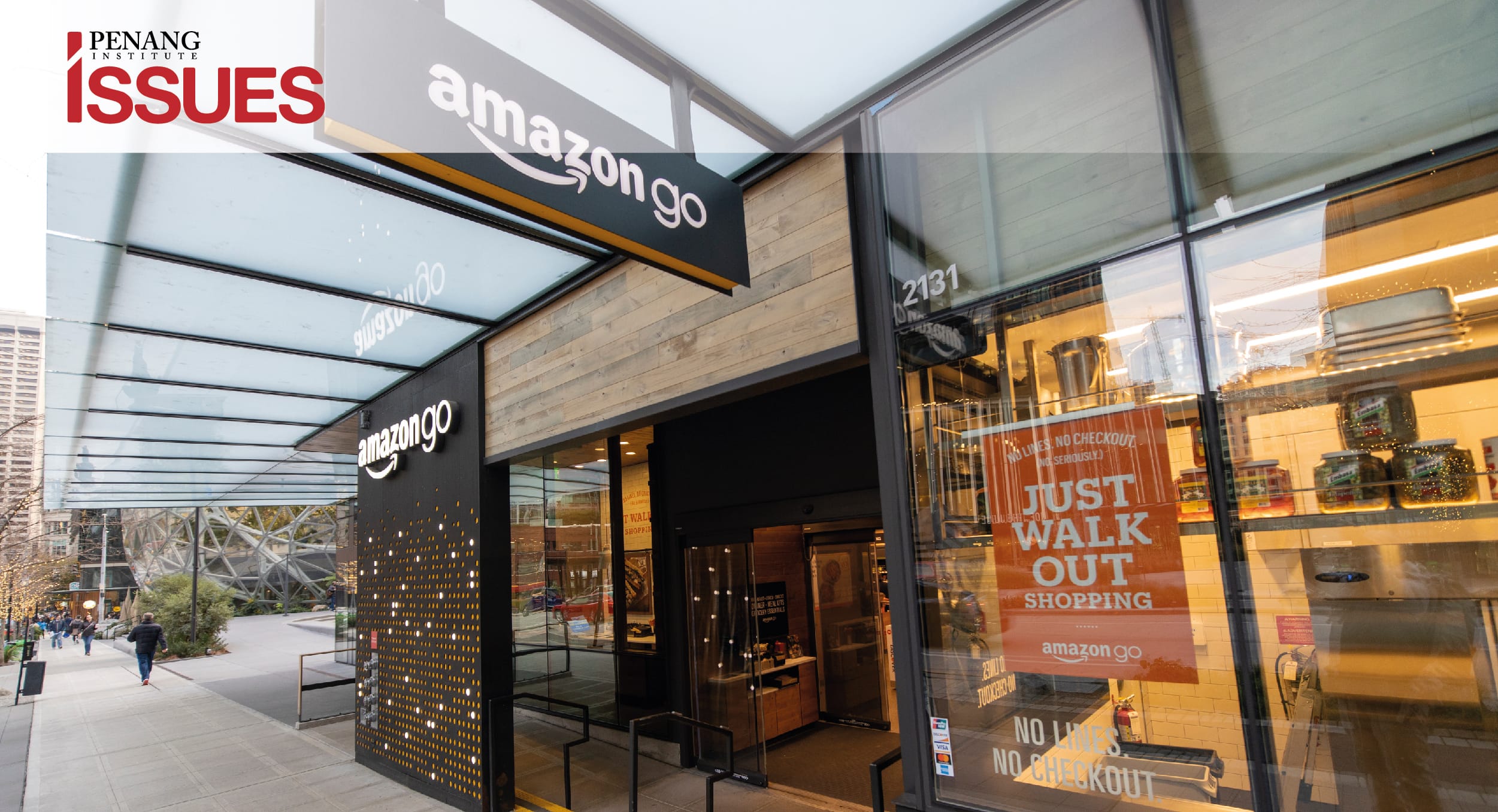Executive Summary
- The experience of grocery shopping changed for many during the pandemic. Cashless payments are now more predominant, and online grocery shopping has become a common option for people who choose to get essentials delivered to their doorstep.
- Moving forward, retailers will need to re-evaluate the number of touchpoints in their stores, and minimise them in order to protect staff and customers.
- Grocery shopping experiences are becoming as contactless, seamless and frictionless as possible in order to avoid virus infections.
- Drawing inspiration from Amazon’s Go Grocery chain in multiple locations in the United States and London, Tesco’s GetGo checkout-free store in London, Cheers (subsidiary of NTUC FairPrice) and Pick & GO convenience chains in Singapore, and multiple other till-free grocery stores in Europe, this paper recommends that Penang similarly integrate this ‘Just Walk Out’ shopping experience soon.
- Policymakers will need to collaborate with grocery industry players, technology providers such as mobile development companies, and financial service companies to encourage the introduction of cashierless grocery stores, and accept this as an inevitable step adapting the retail trade in a post-Covid world.
Introduction
Images of people panic-shopping and queueing to enter shopping malls to buy groceries surfaced at the onset of the Covid-19 pandemic (New Straits Times, 2020) as a shocking phenomenon. Panic buying in general puts a strain on supermarket retailers and results in crowds navigating packed checkout lines (Lufkin, 2020). Waiting in long lines at grocery stores increases the time spent in congested public areas which decreases the ability to physically distance oneself and raises the possibility of virus infections.
Many businesses have been forced to operate digitally during the pandemic. While some shoppers have had the privilege to shop online, many others need and/or prefer to physically acquire their groceries at the stores. In fact, retail technology in recent years started offering self and automated checkout in order to reduce friction and manpower. In Penang, this service has been available at retailers such as Lotus’s (formerly known as Tesco), Mercato, and IKEA. This checkout option requires customers to scan their purchases and pay with their bank cards before exiting the stores.
While this is a meaningful step forward in retail technology, customers still need to wait in line at self-checkout machines and encounter regularly touched surfaces such as the scanner guns and the counter tops.
Seamless, Contactless and Efficient Shopping
Cashierless stores are a new retail concept that is gaining traction globally. It offers a seamless shopping experience which saves time and manpower, and reduces contact which aids in lowering the risks of virus spreading. Artificial Intelligence-driven and fully-automated cashierless technology is a solution that layers digital commerce capabilities onto existing spaces with zero downtime to business (Trigo, 2021).
The pandemic appears to have permanently changed customers’ shopping habits. The wide adoption of e-commerce strongly indicates that consumers’ wish for convenience needs to also be applied in-store. The concept of cashierless stores is a pioneering innovation of what is being called the Phygital (physical and digital) experience. Phygital is a term now used to describe technology that bridges the digital world with the physical world with the intent of providing seamless experiences for consumers (Petro, 2021).
Cashierless shopping technology allows customers to enter stores after scanning the store’s app; they then pick the items they want and exit without waiting at checkout lines. Such stores are equipped with cameras and weight sensors which automatically track customers and the items they pick up (and put down). Once done, shoppers merely leave the store without having to scan the items or to interact with cashiers. Payment is automatically processed upon exit. The purchase history is made available to those who wish to confirm their purchases (Milne, 2021).
Such processes will inevitably be a part of the post-Covid world and are already in place in numerous countries. These unmanned stores also address manpower challenges. Cashierless stores can run 24 hours per day without having to put staff on shift work. While many jobs were cut during the pandemic in general, paradoxically, retail businesses handling food and daily necessities continue to suffer manpower constraints. Unlike other retail businesses, those dealing with daily necessities have continued growing despite the pandemic (Ganesan, 2021). The value of grocery retailers in Malaysia was estimated at RM71.08 billion in 2020 and is projected to jump 30% to RM91.79 billion by 2025. This year, the total is already expected to expand to RM74.74 billion (Euromonitor International, 2021).
With the growth of the grocery retail market, establishing business models that support new lifestyle patterns are feasible and necessary. Improvements in consumer and operational flowlines to include social distancing efforts and the removal of checkout points as possible vectors will be a necessary step in creating safe grocery shopping environments. Cashierless shopping will also be a substantial move in making Penang a smart state.
Importantly, this technology is also easily retrofitted into existing stores.
A Worldwide Phenomenon
Tesco has already converted its branch in High Holborn, London, into its first fully autonomous grocery store allowing customers to shop and pay without using a checkout. Customers now only need to check into the store using Tesco’s app, pick out what they need, and leave without passing any cashier (BBC News, 2021).
The new system, known as GetGo, is similar to stores opened by Amazon, known as Amazon Go in several locations in the United States, and six ‘Just walk out’ stores in London. Amazon initially rolled out the technology in 2018 in Seattle. In June 2021, it opened its largest-yet full-size grocery equipped with its ‘Just walk out’ system, sprawling across 2,300 square metres (The Star, 2021). Aldi UK is also experimenting with this technology while Sainsbury’s trialed its first till-free store in 2019 (McNeice, 2021).
Closer to home, Singapore’s Cheers convenience store chain introduced its first unmanned store concept at Nanyang Polytechnic in 2017, followed by two more such stores within the National University of Singapore. Cheers, which is a subsidiary of NTUC FairPrice, also opened an even more advanced cashierless convenience store at Tampines in 2020 which employs an advanced Artificial Intelligence system that tracks customers’ actions, automatically records items removed from shelves, and uses facial recognition technology for payment (Begum, 2020). Similarly, Pick & Go convenience stores, which was founded in 2019, now has three AI unmanned stores, with its latest store located within the National University of Singapore, and spans more than 3,000 square feet (Yu, 2021). These innovations are reflective of the direction the wider industry is heading.
Table 1: Comparison of Cashierless Grocery Stores in Four Countries

i. Non-exhaustive list
ii. Amazon is an American multinational company which focusses on e-commerce, cloud computing, digital streaming, and artificial intelligence.
iii. Trigo is an Israeli start-up which provides technology solutions that powers grocery stores with frictionless checkout and digitized operations.
iv. Cloudpick is an unmanned retail technology company headquartered in Shanghai which provides AI-based smart store solutions to the retail industry.
v. AiFi is an automated retail technology company headquartered in California with a computer vision platform for autonomous brick-and-mortar stores.
vi. Apart from the data presented in Table 1, there are many more cashierless store initiatives to be found in 2021. For example, Zippin, a checkout-free technology company based in San Francisco has launched an unattended convenience store at a hotel in Japan.
Source: Author’s own compilation.
Issues of theft
Only people who have registered their payment cards, e-wallet accounts, and/or store app will be allowed through the gantry gates of cashierless stores. To ensure security, shoppers are not able to activate the app or enter the store before having added their mode of payment. Customers will similarly need to walk through gantry gates to leave the store. Cashierless stores are equipped with strategically multiple strategically placed cameras, making it easy to identify shoplifting and other misconducts within the store.
Declining jobs for people
An issue which will be questioned with cashierless stores is the loss of employment. However, humans are still needed in these cashierless stores to do a variety of things such as helping customers, preparing food, handling quality checks, replenishing products and more. Manpower will in fact still be needed but will be utilized in a different manner.
Discrimination with customers
Not all customers have smartphones where they can download the store’s app or have credit cards and/ or bank accounts. There must still be an option for manual entry and cash payments for customers who choose to shop the traditional way. In Singapore’s Cheers cashierless stores, the Cheers SG app can register more than one person. This means that people who are not tech-savvy, children, and the elderly who do not have a smartphone or credit card can still enter the store and buy items, as long as their family member’s app has their facial biometrics recorded. The items will be charged to their family member’s registered credit card.
Policy Recommendations
1. Encourage the use of cashierless shopping technology to grocery industry players
A move to introduce cashierless stores in Penang will revolutionize the way retailers and consumers interact with technology. The State Government will need to work with grocery industry players towards bringing in cashierless technology as soon as possible, as the state works towards becoming a smart state. Additionally, the sooner the technology is introduced to the state, the better; cashierless grocery stores will stave virus spreading as more and more people head out to physical stores once again.
2. Collaborate with all stakeholders
The State Government needs to collaborate with all stakeholders to expedite the adoption of such technology in the state. It needs for example to approach big grocery industry players in Penang such as Charoen Pokphand Group (Lotus’s), AEON Group, GCH Retail (Mercato and Cold Storage), as well as companies running convenience store chains in the state such as 7-Eleven Malaysia Holdings Berhad and Maxincome Resources Sdn Bhd (FamilyMart), to discuss converting their outlets to pilot the cashierless technology.
The State Government also needs to partner up with experienced solution providers specializing in equipping physical stores with the necessary technology for checkout-free systems. It would also be ideal to coordinate with e-commerce companies, banking and financial services companies, and mobile development companies for a successful installation of the technology throughout the state.
3. Education to consumers
Digital literacy is at the forefront of the State’s agenda. It is recommended that the State, through Digital Penang, continues encouraging digitalization in the lifestyle of its people through more exposure to smart technologies. It would be ideal that education about such technologies are made easily available and kept simple.
Transparency about data privacy when the technology is made available to the public will also be important in order to gain the trust of consumers.
For list of references and appendix, kindly download the document to view.
Editor: Ooi Kee Beng
Editorial Team: Sheryl Teoh, Alexander Fernandez and Nur Fitriah (Designer)
You might also like:

Towards a Progressive Agenda in a “Totally New Era”

Unleashing Potential: Policy Insights for Malaysia’s Creative Industries

What’s Better than Curing a Disease? Preventing It.

The Value of Private Member’s Bills in Parliament: A Process Comparison between Malaysia and the Uni...

Realising Blue Economy Benefits in Penang


